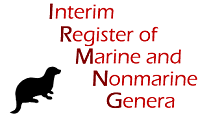
| Intro | | Search taxa | | Taxon tree | | Search literature | | Taxon match | | Homonyms | | Statistics | | Webservice | | Manual | | FAQ | | LifeWatch | | Download | | Log in |
IRMNG taxon detailsSuvorovella A.G. Vologdin & A.B. Maslov, 1960 †
1084851 (urn:lsid:irmng.org:taxname:1084851)
accepted
Genus
marine,
fossil only
Not documented
Taxonomic remark Described as fossil alga; Wood et al., 2017 "tentatively" reinterpret this genus and its allies as "holdfasts
of...
Taxonomic remark Described as fossil alga; Wood et al., 2017 "tentatively" reinterpret this genus and its allies as "holdfasts of [Ediacaran] taxa of unknown affinity, orientated in life by attachment of the apex to, or within, sea floor sediment". [details]
IRMNG (2021). Suvorovella A.G. Vologdin & A.B. Maslov, 1960 †. Accessed at: https://irmng.org/aphia.php?p=taxdetails&id=1084851 on 2025-06-02
Date action by
basis of record
Farr, E. R.; Zijlstra, G. (eds). (1996-current). Index Nominum Genericorum (ING). A compilation of generic names published for organisms covered by the ICN: International Code of Nomenclature for Algae, Fungi, and Plants. [previously: organisms covered by the International Code for Botanical Nomenclature] (2007 version). , available online at https://naturalhistory2.si.edu/botany/ing/ [details]
taxonomy source Wood, R.; Ivantsov, A. Y.; Zhuravlev, A. Y. (2017). First macrobiota biomineralization was environmentally triggered. <em>Proceedings of the Royal Society B: Biological Sciences.</em> 284(1851): 20170059., available online at https://doi.org/10.1098/rspb.2017.0059 [details] name verified source Farr, E. R.; Zijlstra, G. (eds). (1996-current). Index Nominum Genericorum (ING). A compilation of generic names published for organisms covered by the ICN: International Code of Nomenclature for Algae, Fungi, and Plants. [previously: organisms covered by the International Code for Botanical Nomenclature] (2007 version). , available online at https://naturalhistory2.si.edu/botany/ing/ [details] current name source Wood, R.; Ivantsov, A. Y.; Zhuravlev, A. Y. (2017). First macrobiota biomineralization was environmentally triggered. <em>Proceedings of the Royal Society B: Biological Sciences.</em> 284(1851): 20170059., available online at https://doi.org/10.1098/rspb.2017.0059 [details] extant flag source Farr, E. R.; Zijlstra, G. (eds). (1996-current). Index Nominum Genericorum (ING). A compilation of generic names published for organisms covered by the ICN: International Code of Nomenclature for Algae, Fungi, and Plants. [previously: organisms covered by the International Code for Botanical Nomenclature] (2007 version). , available online at https://naturalhistory2.si.edu/botany/ing/ [details] Unreviewed
Descriptive info Lower Cambrian; Ust'Judoma, Siberian Platform, S.S.S.R. (Index Nominum Genericorum) [details]Taxonomic remark Described as fossil alga; Wood et al., 2017 "tentatively" reinterpret this genus and its allies as "holdfasts of [Ediacaran] taxa of unknown affinity, orientated in life by attachment of the apex to, or within, sea floor sediment". [details] |